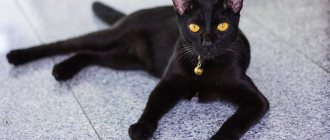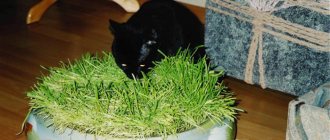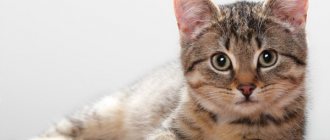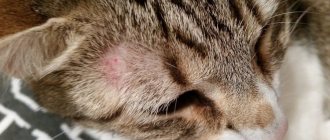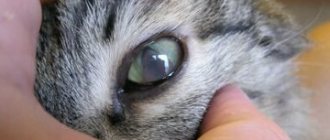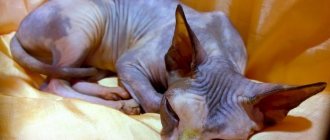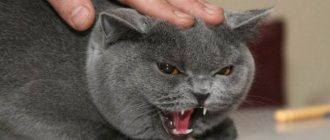- Wild animals
- >>
- Mammals
Forest cats are the ancestors of domestic cute cats. It was these animals that people domesticated about 10 thousand years ago. It was not possible to tame all representatives of this class. There are still a large number of wild cats in the forests, which are afraid of people, but pose a serious threat to small animals.
Origin of the species and description
Photo: Forest cat
Wild cats belong to the group of predatory mammals. The main feature of this class of vertebrates is considered to be feeding their young with milk. The current number of predators of this species is about 5,500 species.
This number includes the cat family, the key features of which include:
- good adaptability to catching prey (animals quietly sneak up, and are also able to watch and pursue prey);
- a small number of teeth (compared to other representatives of predators, cats have only 28-30 teeth);
- a special coating of the tongue with pointed papillae (necessary not only for cleaning fur, but also for scraping meat from the bones of prey).
This particular genus of these individuals is referred to as “Cats”. This group includes representatives of small-sized cats. The most famous representatives of the class are the forest and domestic cats. At the same time, domesticated animals are considered by some scientists as a subspecies of wild ones. The division of cat lineages occurred more than 230 thousand years ago.
The group of forest cats has 22 species of representatives, of which 7 main ones:
- Central European (Felis silvestris silvestris);
- Caucasian (Felis silvestris caucasica);
- African (Felis silvestris cafra);
- Turkestan (Felis silvestris caudata);
- Omani (Felis silvestris gordoni);
- steppe (Felis silvestris lybica), subspecies – domestic (Félis silvestris cátus);
- Asian (Felis silvestris ornata).
Representatives of this class are found in many parts of the world. Their main range is Africa, Asia and Europe.
Kanaani
The birthplace of this breed is Israel. It was based on the genes of a Bengal, Abyssinian cat, Ocicat, as well as a wild Libyan cat and outbred individuals. The result of this “vinaigrette” was a cat with a very interesting character and appearance. The color of the animal can change from apricot to chocolate, but several details must remain unchanged - three rings at the tip of the tail, black socks on the paws, a necklace on the neck. The forehead is necessarily decorated with a clearly visible pattern in the shape of the letter “M”. Despite all the kindness, playfulness and affection, the cat is quite stubborn and self-confident. She does not like to sit on her lap for a long time, moves a lot and organically cannot stand loneliness. He quickly learns household rules and becomes attached to a person.
In addition to the above names and photos of wild cats, there are a number of breeds that are still classified as experimental. It is quite possible that in the near future this list will be replenished with new interesting representatives of the cat family, which will be among the pets in many families around the world.
Appearance and features
Photo: What a forest cat looks like
In appearance, a wild cat can be easily confused with a short-haired pet. These are small animals, reaching no more than 7 kilograms in adulthood. The length of males reaches about 90 centimeters, females - no more than 75-80. They are distinguished from ordinary cats only by their slightly shortened paws and tail (at the same time, due to their characteristics, some specially bred breeds are practically indistinguishable from forest ones).
Video: Forest cat
A distinctive characteristic of wild individuals of the feline class is their rounded muzzle. She is special with her round eyes and erect triangular shaped ears. The mouth of cats is also unusual. Her teeth are smaller (than those of ordinary cats), but much sharper.
The animals' fur is short but thick. There are individuals of almost all shades of gray (dark, light, reddish). On the fur of most wild felines, transverse stripes are clearly visible, running along the entire body and tail (where they become especially clear). Molting occurs twice a year. On the tail the hair is much thicker and slightly longer. The tassels characteristic of some feline predators are absent. The paws of the animals are equipped with sharp retractable claws, which are the main weapon.
External data
The forest cat is a fairly massive and strong animal. The height of adult representatives can be up to 90 cm, and the weight category can be up to 8 kg. Amur cats are distinguished by a longer and bushier tail than other cats. The molting period is also pronounced in these animals. So, in winter, the fur of a forest cat is fluffy, thick and long, very shiny. In the warm season, the animal's coat becomes shorter and thinner, and the undercoat disappears.
Amur cats have superbly developed visual and olfactory functions, which help them survive in the wild. The animal has strong, muscular paws , wide-set ears , sharp and small teeth . The eyes are attractive - large, bright greenish-yellow in color, with a third eyelid that performs a protective function.
The coloring of European cats is very unusual, a grayish-smoky shade, brown or brown color is less common. At the same time, the fur is covered with dark stripes, reminiscent in appearance of the skin of a lynx.
At home, especially in the case of castration or sterilization, growth in forest cats is activated, and the likelihood of developing obesity increases. In many ways, these animals are similar in appearance to domestic cats, differing mainly in their large size and well-developed muscles.
Where does the forest cat live?
Photo: European forest cat
Wild cats are quite common animals. They live in wooded areas of many continents.
The most favorite habitats of individuals are:
- Europe (mainly its Western and Central parts). You can meet animals in Spain and Italy. The range is limited to the north by England and the Baltic Sea;
- Caucasus. Cats also live on the northeastern border with some regions of the former Soviet Union;
- Asia. A greater concentration of animals is observed on the western peninsula of Asia Minor (or Anatolia).
These habitat regions of forest cats are still relevant today. In this case, they are supplemented by the southwestern regions of Ukraine, as well as Eastern Europe. Each representative of wild cats occupies its own territory for housing. Its area is about 2-3 kilometers (in the mountains this figure can be increased several times). Moreover, during the period of searching for a female, males can go much further than the boundaries of their territory. Animals choose mixed dense forests to live. The maximum height of the habitat is 2-3 kilometers above sea level.
Interesting fact: Wild cats are characterized by a hierarchical order of life. For the fertile area, where a large number of small mammals live, males fight “with their fists.”
Animals lead a predominantly solitary lifestyle. Pairing occurs only during the mating period. They try not to get close to human settlements. Low tree hollows act as shelters for wild cats (woody hollows used for breeding are covered with grass and leaves). Individuals living in the mountains prefer to hide in rock gorges, as well as old burrows of other animals. Moreover, if there is both a badger hole and a hollow at the same time, the cat will choose the first type of shelter.
Now you know where the wild forest cat lives. Let's see what he eats.
Lifestyle and nutrition
The European wild cat is distinguished by its agility. If she senses danger, she will immediately climb a tree and hide from pursuit at a height. Forest cats can live not only among trees, but also near rivers.
They can find temporary shelter in abandoned hollows, holes, and sometimes even in large heron nests. As a rule, cats create shelters for themselves in winter to wait out the cold. At the same time, they do not stop hunting and are rightfully considered excellent hunters.
Cats often flee from an impending threat in places where there are many badger holes. Subsequently, they can use these holes as a home.
Animals most often wait out the day in the den, and go hunting at dusk. They hunt before sunset and at night, and then go back to their homes. It is noteworthy that during the period of shallow water, forest cats begin to feed on the inhabitants of reservoirs and rivers.
What does a forest cat eat?
Photo: Wild forest cat
Cats obtain food by hunting smaller animals. The diet of forest predators largely depends on the season.
In good weather, the main prey of a feline hunter is considered to be:
- small animals (mice, squirrels, chipmunks, weasels, minks, etc.);
- amphibians and reptiles (frogs, snakes, lizards);
- fish (small representatives swimming mainly near the surface of the water);
- birds (and especially chicks or eggs left by winged parents in the nest).
Hunting cats give preference to those birds that live and nest on the ground.
Interesting fact: Particularly insightful and fearless representatives of wild cats are capable of killing a hare, roe deer or even a deer! True, this only happens when a large animal is already weakened and is not able to move quickly, or defend itself from cat attacks.
In winter, things are much worse with food. Due to heavy snow and frost, the number of birds is reduced, many animals prefer to hibernate or simply sit out in warm shelters, and fish hide under the crust of ice that covers the river. Hunting is very difficult. Cats have to track and wait for their prey for a long time. It is precisely because of the difficult hunting conditions in winter that the animals gain most of their weight in the summer. The accumulated fat allows them not to freeze and maintains the normal functioning of organs.
Interesting fact: Only in winter can felines approach human settlements. Here they brazenly steal chickens and other small livestock.
Wild cats hunt only at night. The best time to capture prey is sunset and dawn (between these events the animal sleeps in its shelter). Moreover, if it rains at night, the cat refuses to be hot.
Habitat and role in the ecosystem
The forest wild cat can be found in certain parts of Europe, in Asia Minor, in the southwestern regions of Ukraine, as well as in Russian territories up to the Caucasus Mountains. The animal prefers to settle in remote, remote mixed deciduous broad-leaved forests (sometimes coniferous). It can live in mountainous areas (rocky areas) at an altitude of more than 2–3 km. Sometimes it chooses river banks for habitat, settling in dense bushes or reed thickets.
Wild cats establish permanent dens in abandoned badger and fox holes or in the hollows of large trees, without climbing too high. The dwellings are lined with dry litter consisting of leaves, grass, small branches and feathers. Temporary shelters are depressions under steep rocky slopes, small holes, or simply a dense interweaving of branches. The animal often uses old abandoned nests of large birds (herons) to rest.
Wild European cat may make temporary shelter in trees
In the warm season, it often changes rookeries, trying to escape from fleas and other blood-sucking parasites, which especially plague the animal in summer. In the midst of winter, it can use one den for a long time, since it is difficult to move through deep snow. There have been cases when forest cats settled in the attics of granaries, cottages, sheds and other buildings.
An animal that settles near human habitation can cause significant harm, as it will prey on poultry. Since in some cases a cat eats only small rodents, it is often beneficial in the wild. But it can destroy eggs and chicks of valuable bird species (turk, pheasants, etc.).
Along with the fox, the wild forest cat is considered a carrier of a number of dangerous infectious diseases (rabies, toxoplasmosis, etc.).
Features of character and lifestyle
Photo: Amur forest cat
Forest cats are freedom-loving animals that prefer to live alone and do not tolerate competitors on their territory. They have a wary character and often show aggression towards other animals or approaching people (which can be noticed even when visiting a zoo).
Hissing at a person is typical even for those forest cats that they tried to tame. Animals cannot be trained, do not recognize people as heads of the house and, in principle, avoid all neighbors. You cannot have such a pet in a small apartment. He needs a large area - at least a dacha yard. It is worth considering that the animal loves to climb trees and inspect its possessions. There is no need to limit it in this regard.
However, it is likely that at the first opportunity the “domestic” pet will run away from its owners, preferring a wild lifestyle. Forest cats make sounds only during the mating season. In steely times they are very silent. Only occasionally from their “mouths” can one hear the whistling, hissing and howling that is characteristic only of them. All these sounds are produced by cats when aggression is shown towards them. Animals react very quickly. Perhaps this is due to excellent vision, developed hearing and a special sense of smell.
Varieties
Norwegian forest cat
The Norwegian Forest Cat is a fluffy beauty from Scandinavian myths. Legends describe a predator with the name “Forest Cat”, capable of running along steep cliffs. Similar Norwegian cats carried the beautiful goddess Freya in harness.
In our time, the king took the beautiful animal under his personal protection, granting him the status of a national cat. For centuries, the Norwegian forest cat lived next to people, some individuals served as mousecatchers on merchant ships. This type of forest cat was even exhibited at the International Cat Show in Germany in the last century.
Recognition of the Norwegian Forest Cat as a separate breed saved the subspecies from extinction. Cats were brought to Russia, and through human efforts they reached the United States. Professional breeders started breeding the breed. It has been proven that this is a Norwegian cat - the closest relative of the May Coon.
The Norwegian forest cat is the largest subspecies, reaching a mass of ten kilograms (exceeding the size of a dog). Strong paws allow them to run head down from almost vertical surfaces. But as your pet ages, joint problems appear.
The Norwegian forest cat living in the north is better insulated than other subspecies. There is thick fluffy fur and abundant undercoat. The ears and spaces between the fingers are covered with a warming layer.
Caucasian forest cat
The Caucasian forest cat is a subspecies protected by the Red Book; it was hunted too much in the last century. Lives in the highlands of the Caucasus and Turkey. They live alone, hunt small rodents and birds, but can feast on a hare or a weakened roe deer.
Typically, the Caucasian forest cat is gray in color with pronounced dark stripes, but there are also black specimens. This subspecies of the forest cat has changed the least; it does not interbreed with domestic cats.
The subspecies is distinguished by its large size; the male Caucasian forest cat often reaches ten kilograms. By winter it acquires insulated fur, which allows it to hunt in mountain winter conditions.
In Dagestan, cats have taken a liking to the river banks; the inhabitants of Georgia often go down to the sea beaches. And in the area of Batumi and Poti, the Caucasian forest cat lives in the “wet” conditions, hunting every day in rivers and walking on wet dirty grass. The local forest cats even swim in streams when hunting for fish.
Far Eastern forest cat
The Far Eastern forest cat “disguises” itself as a small tawny leopard. His light coat is evenly covered with red “leopard” spots.” This is a skilled nocturnal predator that lives in hard-to-reach places.
The Far Eastern forest cat is a close relative of the Amur forest cat; sometimes they, descendants of the Bengal cat, are combined into one subspecies. The Amur forest cat is distinguished by three dark stripes stretching along its back and light sides. The body is strewn with coin spots, for which the Chinese nicknamed this subspecies “money cat.”
Amur forest cat
The Amur forest cat has inhabited the forest expanses of the Far East, its habitat extends to the Amur, the coast of the Sea of Japan, and reaches Hindustan and the Malay Archipelago. Many forest cats of this subspecies live in the lands of China.
Leads a nomadic lifestyle, swims remarkably well, and sometimes lives in pairs. In cold weather, predators move to lowlands not blown by the wind to escape drifts near human habitation. This forest cat gets used to humans better than others; it can be kept in an enclosure, away from strangers.
The European wild cat is the most similar to the domestic cat. The same gray skin and stripes, only the fur is tall and thick. Lives in the Caucasus regions, in low mountains, in the forests of Ukraine, in European countries. Selects an area with dense forest.
Social structure and reproduction
Photo: Far Eastern forest cat
Unlike domestic cats, forest cats mate only once a year and mainly between January and March. The female and male unite in a union only for the time of conception of offspring. Cats lure cats with a characteristic smell that spreads after the territory has been marked. The males responding to the scent begin a fierce fight among themselves.
The female allows only the strongest to approach her. The mating process takes place in a hollow tree (at a short distance from the ground) or in a hole abandoned by another animal. In this case, the mating site is arranged in advance for the young offspring. The “floor” is covered with leaves, grass and even bird feathers. After the kittens are conceived, the parents separate again. The expectant mother is left alone and awaits the birth of her offspring, taking care of them in advance. She arranges the home in the best possible way for childbirth.
Pregnancy of wild cats lasts for 2-4 months. At one time, a female is capable of giving birth to from 1 to 7 kittens. All cubs are born blind (sight comes only on the 9-12th day after birth) and helpless. They weigh only 250 grams and practically do not stand on their paws. They cannot do without maternal help in the first weeks of their life. The mother takes care of her cubs with love and reverence. It provides them with food and security. Only at one month do kittens begin to actively crawl. And already at 2, they go on their first hunt with their mother. Kittens that are more than 2 months old are very voracious. They are able to pet up to 7 mice a day, supplementing their diet with mother's milk.
Baby cats are very playful and inquisitive. They quickly move around their parent territory and move through the trees without fear. At the age of 5 months they set off into adulthood. The cats leave their mother's land and begin searching for their hunting territory. Cats remain within the mother’s area, but set up their own den. Sexual maturity of animals occurs at the age of 10 months.
Reproduction
The rut begins in the spring, when cats come to the habitats of females and begin to attract the attention of the latter. If two males come to the female at the same time, then rival fights begin with loud meowing and fights, where the strongest wins.
There are cases when cats covered cats living with humans, but in this case the kittens turn out to be uncontrollable.
A cat, before giving birth to kittens, organizes a rookery for itself, lining it with bird fluff and soft grass. Pregnancy lasts 2 months; in May, blind forest kittens appear in a litter of up to 5.
The forest kitten develops very quickly; after a couple of weeks, its eyes open. When the kittens turn 2 months old, the mother begins to take them hunting with her, teaching them to get food on their own. At the beginning of autumn, these are already quite adult individuals that leave their mother to find their own territory. A lot of teenage kittens die from predators that live in the same places. Males do not take any part in raising kittens.
Natural enemies of forest cats
Photo: Siberian forest cat
Forest cats are very dexterous and agile creatures. It is very difficult for other predators to hit them. Thanks to their ability to quickly jump from branch to branch (the length of the jump can be 3 meters), move through thickets and swim, felines easily hide from potential rivals. At the same time, the animals have enough enemies.
The main ones are:
- Foxes (dangerous for almost all species of forest cats, this is due to the expanded habitat of foxes);
- Jackals (they pose a threat to felines living in Southeast Europe and Asia);
- Martens (they hunt forest cats in the mixed forests of Asia and Europe);
- Lynx (such animals threaten mainly cats living in the northern hemisphere).
The main predator of forest cats (no matter how strange it may sound) are martens. Despite their significantly smaller size, they quickly infect young cats, contenting themselves with their meat.
Interesting fact: Despite the fact that jackals are considered enemies of forest cats, they themselves are afraid of these animals. When meeting a wild cat, the jackal will prefer to abandon the carrion it has caught, returning to eating it only after the animal has left.
Most cats become prey due to old age, illness or injury that limits normal movement. In standard situations, it is extremely difficult to catch up with the beast.
Health and disease of the Norwegian forest cat
Natural selection, which determined the development of the breed for several centuries, led to the formation of a strong and healthy population. Of course, recent human intervention - selective breeding, a limited number of genetic lines - has had negative consequences, but in general, Norwegian forest cats remain strong and hardy. They are at risk of only a few serious diseases:
- restrictive cardiomyopathy – decreased compliance of the heart muscle and subsequent development of chronic heart failure;
- diabetes – dysfunction of the endocrine system due to insulin deficiency;
- hip arthrosis is a chronic joint disease;
- retinal dysplasia - abnormal formation of retinal layers during intrauterine development;
- chronic renal failure – decreased kidney function;
- glycogenosis type IV - a genetic disease that provokes liver metabolic disorders and cirrhosis, such kittens are born dead or die soon after birth, in rare cases they live up to 4-5 months;
- Purivate kinase deficiency is another genetic disease that causes a reduction in the number of red blood cells and anemia.
The last two are becoming less common today, since genetic analysis makes it possible to identify carriers of recessive genes and exclude the possibility of having a litter from two carriers.
At the age of 6-8 weeks, the first injection of a polyvalent vaccine is carried out (most often this is the concern of the breeder, not yours), repeated vaccination is carried out at 6-8 months. Next, it is enough to do the vaccinations recommended by your veterinarian annually.
With due attention to the health of the cat on the part of the owners, proper nutrition, sufficient physical activity and the absence of congenital diseases, Norwegian forest cats live 15-16 years, maintaining activity and a tenacious mind.
Norwegian Forest Cat in its element
Population and species status
Photo: What a forest cat looks like
The exact number of forest cats in their natural habitat is unknown. This is explained by its constant change.
The animal population is declining for several reasons:
- Burning of forests (which occurs as a result of careless human actions);
- High level of garbage (because of it, smaller animals die, which cats feed on);
- Poaching (many hunters try to get a live wild cat in order to domesticate it).
The decline in the number of animals is also due to floods, as well as global climate changes, for which animals are not always prepared. It is worth noting that in some areas the wild cat population has been completely exterminated. Until 1927, two representatives of the cat class could be found in Belarus: lynxes and forest cats. Today, there are none left in this area. Zoologists consider human activity to be the main reason for the extermination of animals. The human desire to become the owner of a unique breed of cats or to enrich themselves by selling it has led to a sharp reduction in the number of representatives of this group in the natural environment.
Interesting fact: To restore the population of forest cats in Belarus, it was decided to purchase animals in Moldova for their further settlement in the state Polesie Nature Reserve.
If it were not for the illegal actions of people (pollution of nature, arson), the number of animals would be much higher. However, forest cats are not currently under serious threat. The only exception is one of the 22 existing species. We are talking about the Caucasian forest cat (Felis silvestris caucasica), listed in the Red Book in Russia.
History of the origin of the breed
Wild cats as such appeared during the Pleistocene era, which ended 11.7 thousand years ago. Then the weather was extremely harsh, most of the time the Earth was cold. Sometimes there were relatively warm, favorable periods. In some places the weather changed rarely and dramatically, becoming either terribly hot or impossibly cold.
During the Pleistocene, many different species of animals appeared on Earth, many of which eventually died. This is due to the fact that the Pleistocene era ended with the Ice Age.
The exact date of the emergence of wild cats is not known. It is a well-established fact that they appeared on Earth before the Ice Age.
Wild cats survived the coldest period, after which they began to adapt to life in dense forests. The animals were able to settle in the forests, and still live there. Hence the name – forest cat.
From the name of the breed one can also understand that the first thing its modern representatives were brought to Europe. Previously, representatives of the species occupied a vast part of central Europe, now - western and eastern.
Previously, Russian forest cats lived on the territory of the USSR, mainly on the northeastern border with the Caucasus. Now wild cats remain in the Caucasus. And this does not in any way change the fact that forest cats are very rare in Russia.
There is a certain problem associated with the fact that sometimes forest cats mate with stray cats. Because of this, unclean offspring appear, threatening the entire species with extinction. The Scottish forest cat especially suffers from this problem. In other countries, there are much fewer mixed-breed cats.
Scientists say that there is no need to focus attention, since due to the appearance of non-purebred kittens, the species will not go extinct anyway. Despite this, the purebred breed is listed in the International Red Book.
Description of the breed
The harsh climate of the Scandinavian countries endowed northern cats with thick hair with water-repellent topcoat, large paws with strong claws and hunter instincts.
Standard
- Body : strong, slightly elongated with well-developed muscles. Average weight: cats – 5.5-6 kg, males – 6-9 kg.
- Limbs : The difference in length between the hind and front legs creates a smooth rise of the body towards the tail. Large round feet with hair between the toes. The tail is equal to the length of the body, heavily pubescent.
- Head : large, triangular in shape. The forehead is wide, the stop is weakly expressed. All lines of the head are smooth. The lower jaw is rounded. The nose is straight, even, the color of the mirror matches the coat.
- Eyes : large, oval-shaped, located at a slight angle. Any eye color is allowed.
- Ears : large, wide, slightly rounded at the tips. In front view they are set strictly vertically, in profile they are slightly tilted forward.
- Coat : Semi-longhaired, length varies on different parts of the body. The fur reaches its greatest length on the collar, pants and mane around the head. A distinctive feature of the Norwegian cat's coat is its double undercoat. The top hair has a water-repellent layer.
- Color : wide variability of coat color, point colors are not allowed . Accepted colors according to FIFe: solid white, tri-color, blue, gray, black, red (red), cream, combinations of black and blue, black and blue and white. The most common color is tabby and white - a tabby cat of black and red color with white paws, chest and a star on the forehead.
Photos of colors
Black color
White
Red (red)
Grey
Blue
Tabby
Tortoiseshell
Black and white bicolor
Important! There is currently controversy over some of the colors that are particularly rare for Norwegians: lilac, fawn and cinnamon . Kittens with these colors are still subject to disqualification, but the appearance of such colors in purebred Norwegians calls into question the correctness of this decision.
Differences between Norwegian Forest and Siberian cats
The Norwegian Forest Cat is somewhat similar to the Siberian cat, Turkish Bath and Maine Coon, but has more in common with the Angora.
Siberians and Norwegians developed in the same conditions, which led to external similarity, however, an experienced felinologist can easily distinguish between the two breeds.
| Norwegian Forest Cat | Siberian cat |
| The head resembles an equilateral triangle | The head is round, the muzzle is trapezoidal |
| Nose straight | Slight snub nose |
| The body is elongated | Average body length |
| Maximum weight – about 9 kilograms | Maximum weight – 12 kilograms |
What is the difference between Maine Coons, Siberian and Norwegian cats:
